I’ve met a lot of parents in my life, and only one of them has ever told me that they regretted the decision to have a child. While I’m sure plenty of parents, at least some of the time, have actually regretted their decision to have kids, there are tremendous social and biological pressures acting against coming right out and saying it to anyone else.
Now kids and dogs are different concepts altogether (although the later is often a gateway drug that leads to the former), but the notion that you can regret a decision to get a dog and undo the damage by finding it a new and better home once you realize that you’ve made a horrible, horrible mistake comes with social pressures to.
I am not a dog person by nature, but in a moment of post-breakup-panic in the late 1980s I found myself the shepherd for an irascible lab-spaniel cross named Penny. I did actually love Penny and appreciated the role she played in my life (although many of my friends and family, after Penny, say, ate their Birkenstocks or their broccoli, were less enthusiastic). Eventually Penny became incompatible with my jet-setter lifestyle, and I was very fortunate that my late friend Lorna Hutcheson agreed to a sort of temporary adoption arrangement which ended up turning into a permanent adoption when the jet-setting took me out of reach and out of money from Penny’s new home base. Penny lived a free and happy life and, irony of ironies, eventually moved with Lorna and family to Prince Edward Island, where I was able to see her in her golden years were she was more an “irascible emeritus.”
This is all a roundabout way of sending props to my friends Paul and Lori, who got an adorable tiny dog a few weeks ago – a sort of poster dog for “adorable tiny dogs,” in fact – named Birdie. And then, as Lori explains in her blog:
Birdie is such a sweetheart, but she turned this little family right upside down and me into a crazy person.
And so Birdie has gone back home, and Lori and Paul’s life has returned to a steady state. Birdie makes an appearance in today’s The Small Fancy (which is always one of the highlights of my Friday).
In a fascinating profile of director Guillermo del Torro in the February 7, 2011 New Yorker, Daniel Zalewski writes:
Del Toro often spends months planting “visual rhymes” in his movies; the tunnels that Ofelia travels through in “Pan’s Labyrinth,” for example, all have “feminine apertures.” What others call eye candy del Toro calls “eye protein.”
and then, later:
For several months, del Toro said, he had been working on the dragon. “It will be a very different dragon than most,” he said. He proposed discussing it over lunch. He went upstairs to retrieve several notebooks. “I keep my journals locked in a safe in my bathroom,” he said abashedly, as if this had been the afternoon’s sole display of eccentricity. As we left, I noticed that several boxes of eye protein from Amazon—comic books, DVDs, model kits—had been tossed onto the floor before Sammael’s gaping maw.
I thought of this tonight, walking home through the lively Saturday night streets of Kreuzberg, on my way home from the Cognitive Cities Conference after-party.
Why, after all, would I, who spends his days buried deep underground in the Drupal mine, feel it important to attend a conference centering on such esoterica as “Urban Mobility,” “Sensing Infrastructure” and “Cognitive Buildings.” These are not, much as I might wish, the stuff of my day-to-day life. And even if they were, the talks at the conference, boiled down, were little more than (beautifully illustrated, cogently argued, well-presented) sermons advocating for particular approaches to the use or misuse of digital data in an urban context.
In other words, if I had to account for my presence to an employer, given my daily remit, I would be hard pressed.
But here’s the thing: Cognitive Cities – or really any conference worth attending – isn’t really about what’s up on the stage.
What happens up on stage is, to use del Toro’s phrase, eye protein. And as protein is digested into amino acids such that we might thrive and grow, so is eye protein digested by the mind and re-synthesized into new ideas and connections and relationships that otherwise wouldn’t exist.
So it’s important that what’s up on stage is rich and interesting and passionately presented. It’s not particularly important, however, that it shoots directly into a personal nerve.
Which is all a roundabout way of saying that sitting in a room with 300 generally like-minded people listening to someone talk about, say, “norm creating structures,” might, despite all immediate evidence to the contrary, be a necessary pre-condition for “seasoning” the mind and creating an environment where learning, accepting new points of view, developing novel ideas, and meeting new people, is more likely to happen.
All of which is a phenomenon likely familiar to regular church-goers: surely it can’t be the labyrinthian stories of the Sunday sermon that are the attraction; I assume, rather, that it’s the shared experience, the exercise for the mind, the doorway to the spirit propped open ever-so-slightly more, that is what’s really important.
And I can attest that, after eight hours praying in the church of the cognitive city, I did indeed emerge “seasoned.” In amongst my notes – “find out more about the Välkky traffic sensor,” “what does normative mean, anyway,” “there is no structure, only information,” “cities are serendipity hubs,” “the acoustics of old sounds” – are a dozen things I want to run right home and try out.
New projects. New takes on old projects. Things I’d forgotten I never finished. Things I’d forgotten I never started. Some of them directly inspired by the conference, but many of them not all all related and yet things that came to me nonetheless, what with the spirit doorway being open and all.
Overcoming day-to-day inertia is incredibly difficult: comfortable patterns are, well, comfortable. And yet to grow requires seeing new patterns, and seeing new patterns means overcoming the inertia to not seeing new patterns. And one way to get there is to change the place, change the stage, and to consume massive amounts of eye protein.
And that is why, on this cold weekend in February, I find myself in Berlin with a bunch of city hackers talking about how to make the sentient city.
Last March when Oliver and I came to Berlin we happened upon the Kreuzberg Museum, a delightful little museum of a Berlin neighbourhood. On the first floor of the museum is a working letterpress print shop, and it was there that I got my first taste of letterpress printing. It seemed only appropriate, thus, that after a year spent delving into printing, on this visit to Berlin I should return to the scene of the crime and do some actual printing there.
Forces coalesced to make this possible: my friend Igor generously sent himself out as an advance team last month and established that such an endeavour might be possible, and then he and I returned yesterday to seal the deal. The printer was extremely accommodating, agreeing to let an unknown Canadian of no demonstrable skill loose in his print shop.
And so this morning my friend Luisa – also in town for Cognitive Cities – and I took the 10 minute walk from my apartment to the print shop, made our introductions, choose a typeface and a nice, solid old German platen press, and set out to do some printing. The printer was around to help if we needed it, but mostly let us fumble our way along; fortunately printing in German on a German letterpress isn’t a lot different than printing in English on a British letterpress.
My goal was to produce a set of German “flash cards” for Oliver – two cards printed with each word to allow him to play a memory game and, with luck, to learn the meaning of the words. It was a labour-intensive project, as it involved setting type and printing 20 individual words. Fortunately Luisa, a quick study, was a great help all the way through (she managed to print business cards for herself and her partner while she was at it), and four hours later we emerged with the memory game set and printed. It was the most fun I’ve had in a long time.
The type I choose was a very pleasant, heavy 20 pt. serif face; I printed on a a package of “karteikarten” I bought on Tuesday night around the corner at a Kreuzberg paper store for 1.95 EUR. Here’s the story in photos:
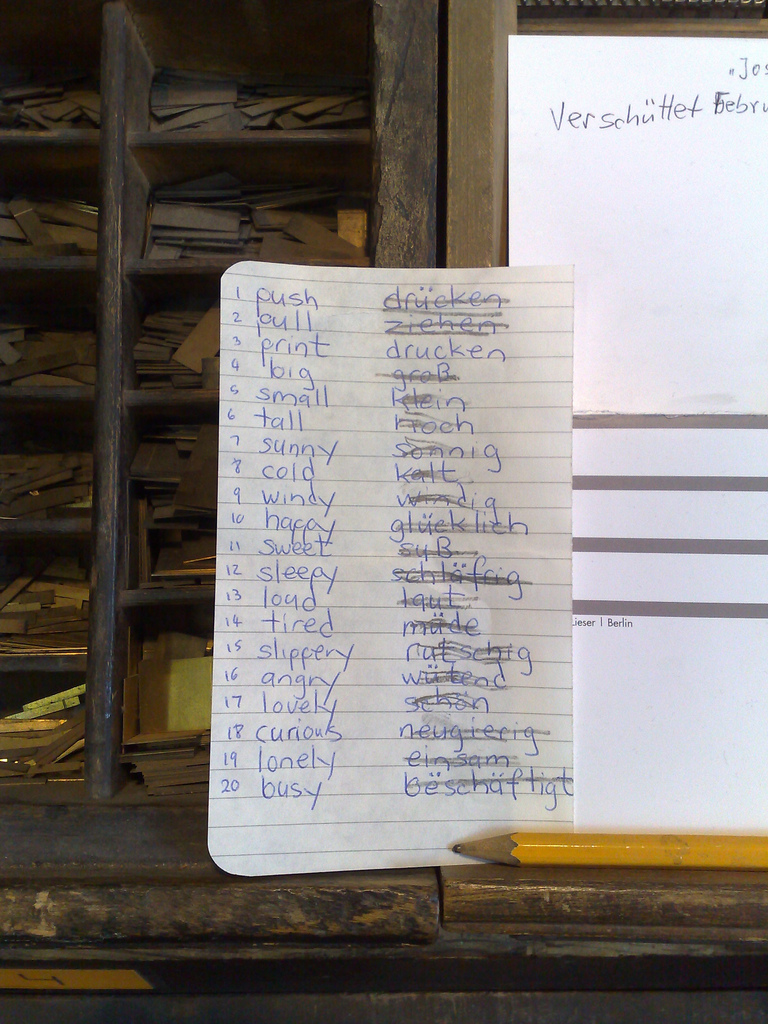
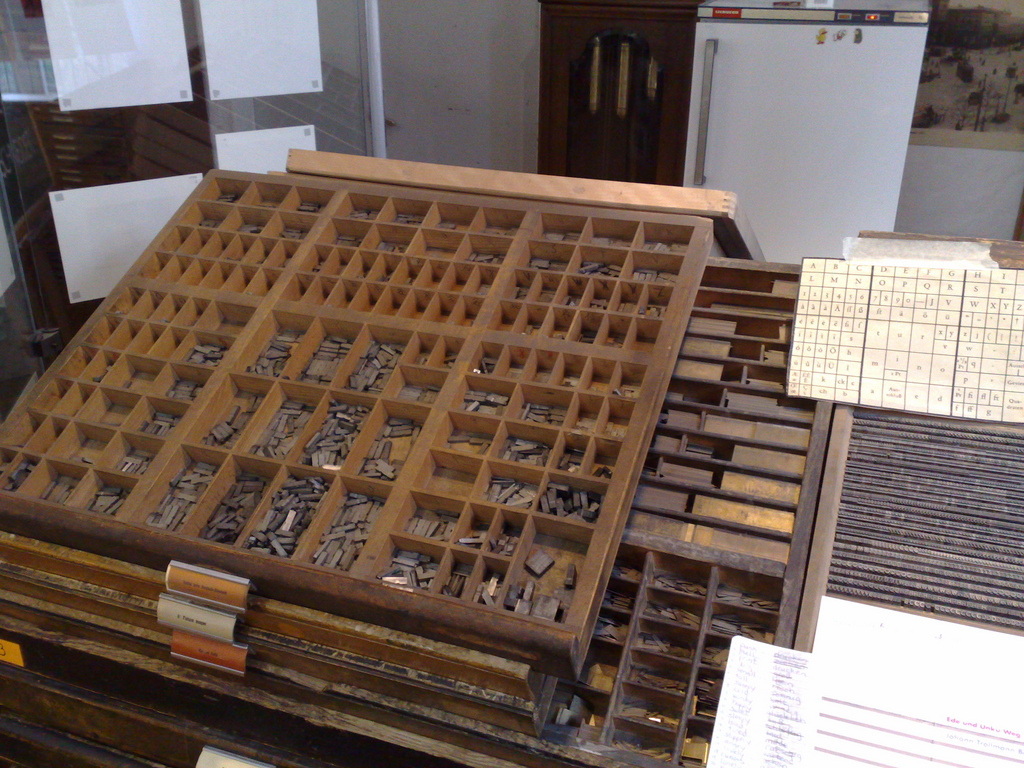
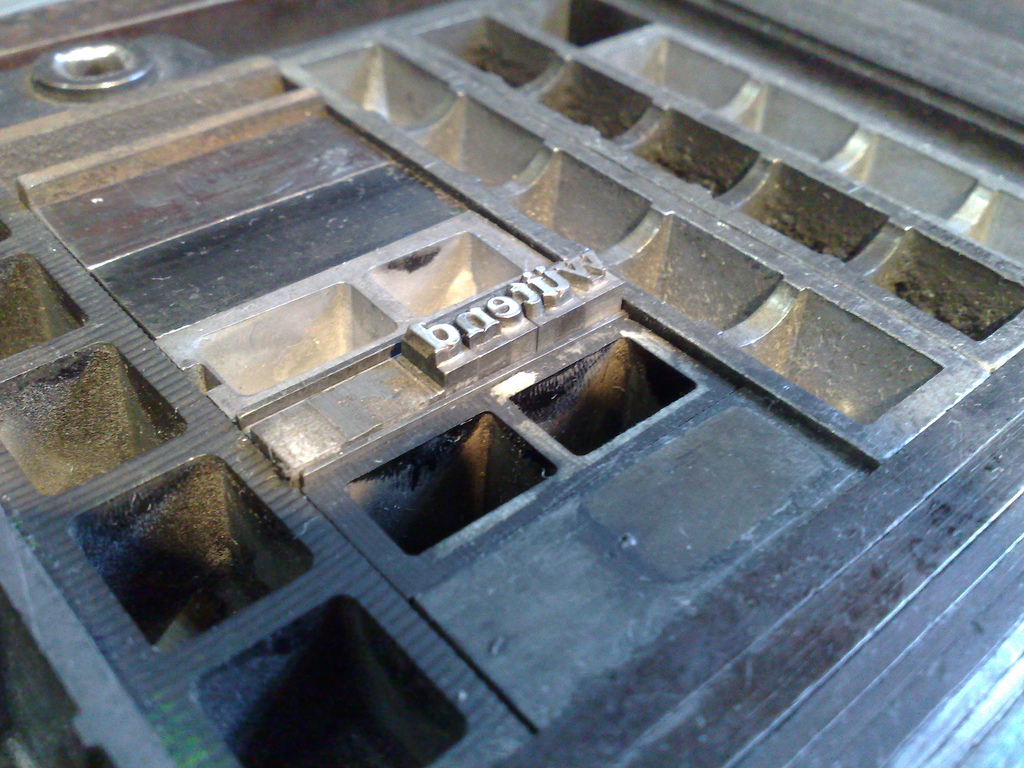
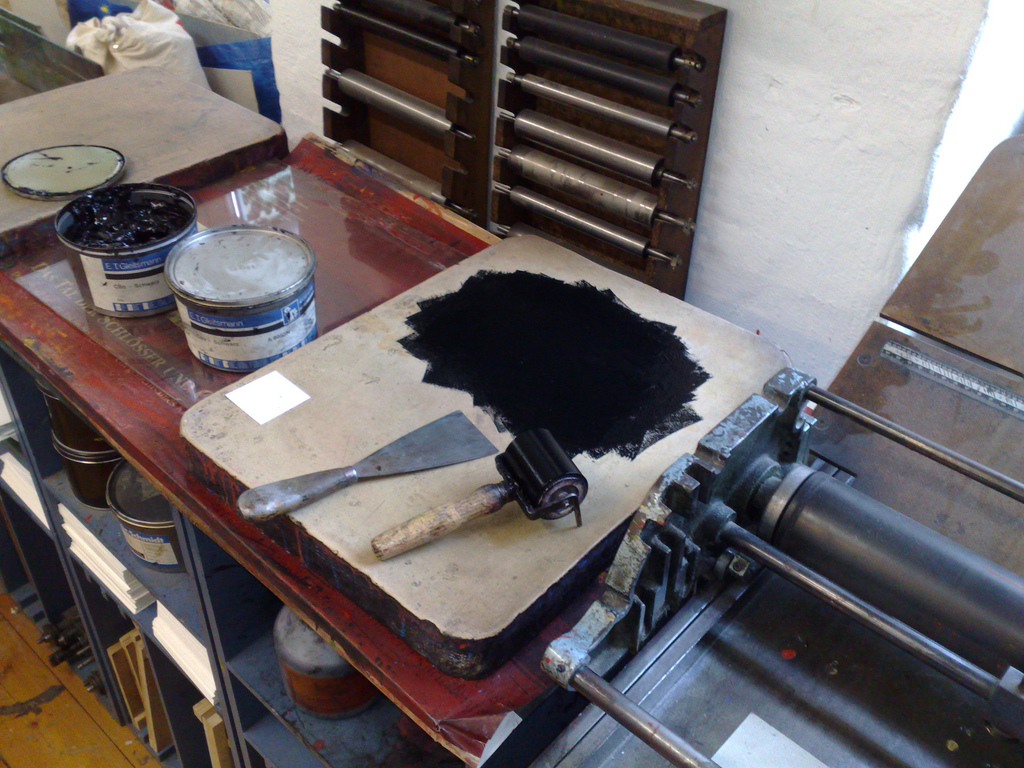
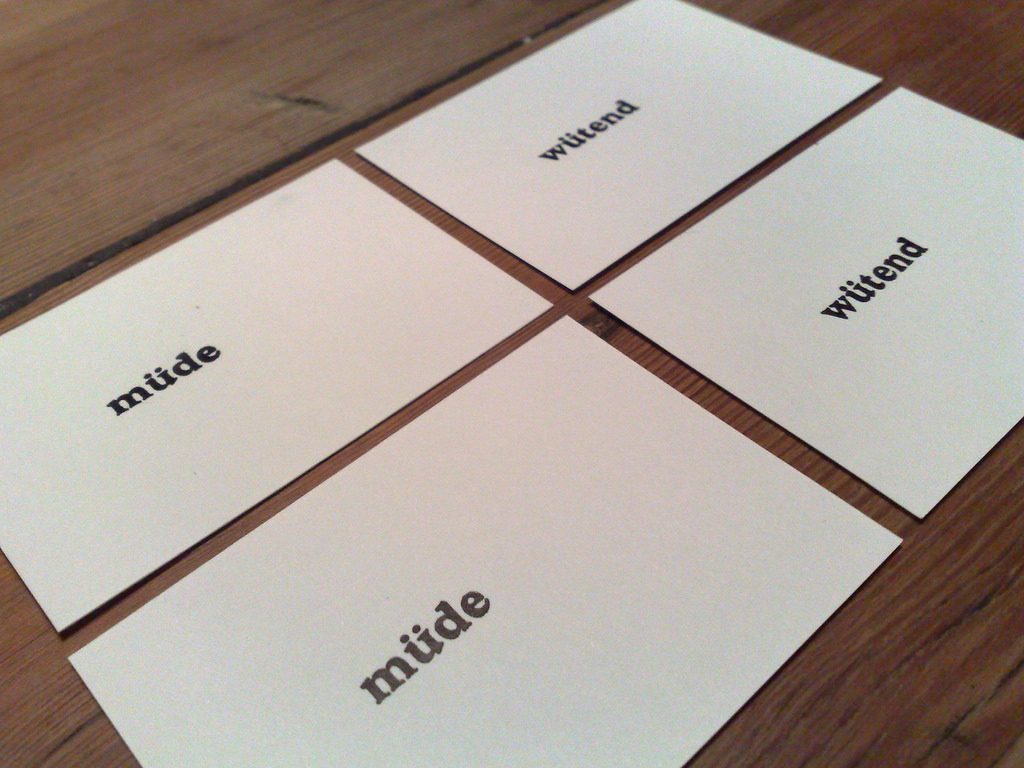
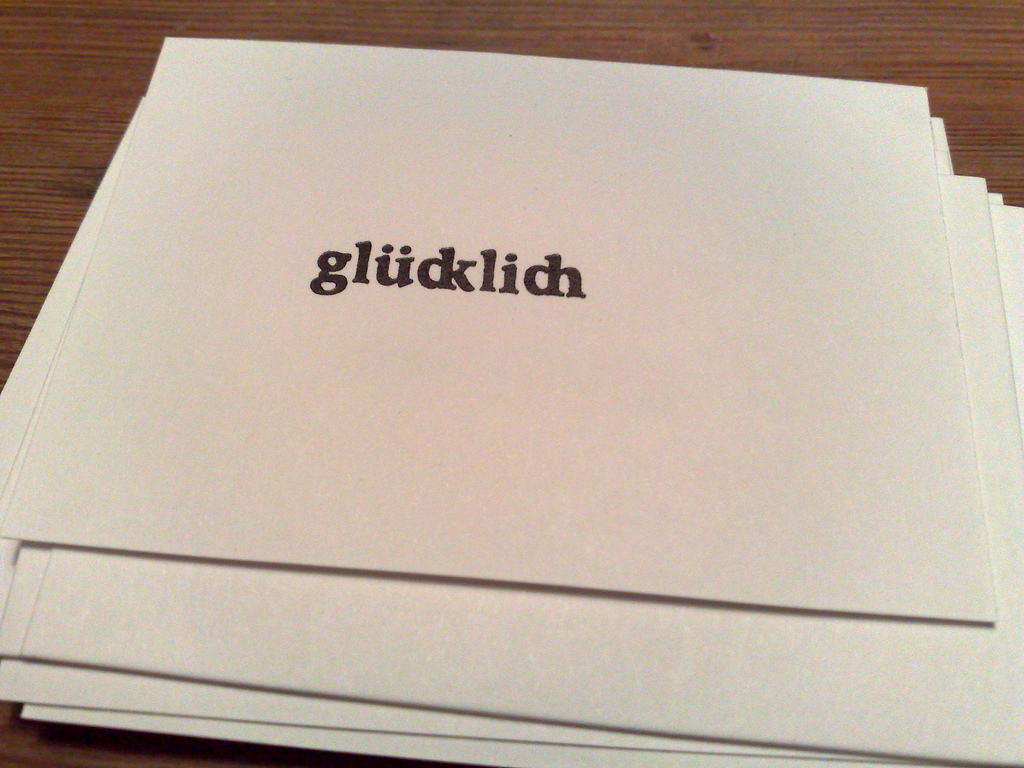
I’ve had a very pleasant day in Berlin, starting with a hearty breakfast purchased last night at a nearby health food store. Spent the morning in Mitte buying magazines and paper, had lunch with Igor and the Third Wave Crew at a Korean chicken place in Kreuzberg, dropped by the Kreuzberg Museum with Igor as translator to set up a letterpress session for tomorrow morning, headed out to see Martin Z. Schröder letterpress shop in the afternoon and finished up with some more paper shopping before heading home (the quality and number of Berlin’s stationery stores is mind-boggling; I could spend all day every day browsing through them). Here’s the day in three photos (hover over them for notes and links).
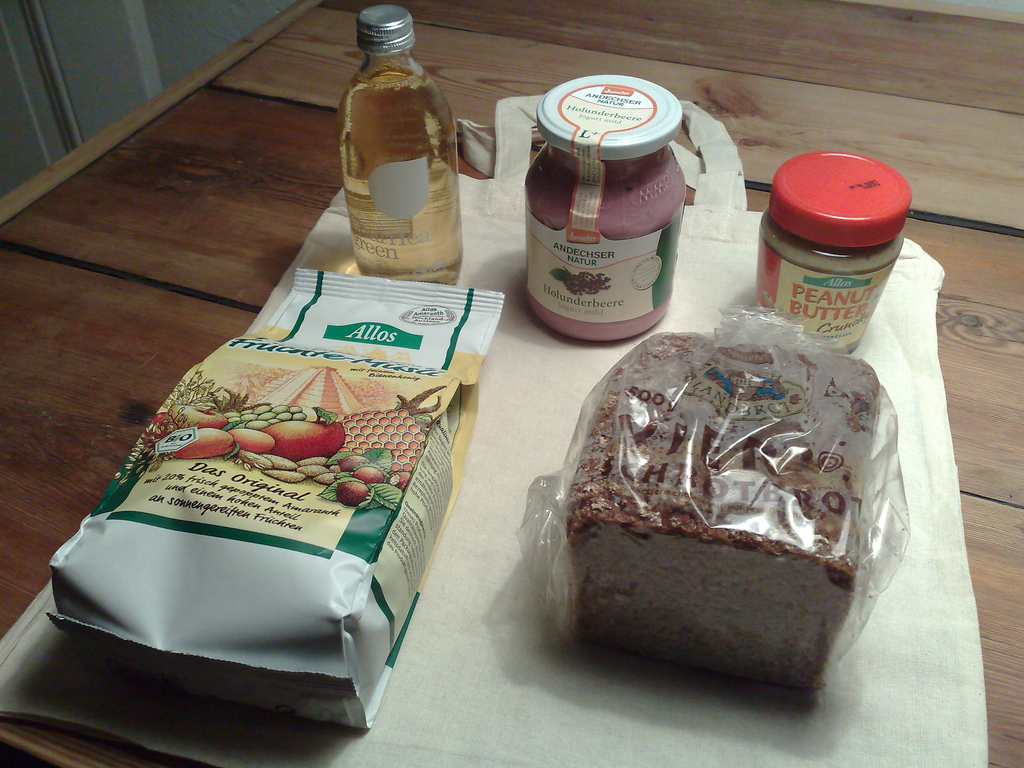

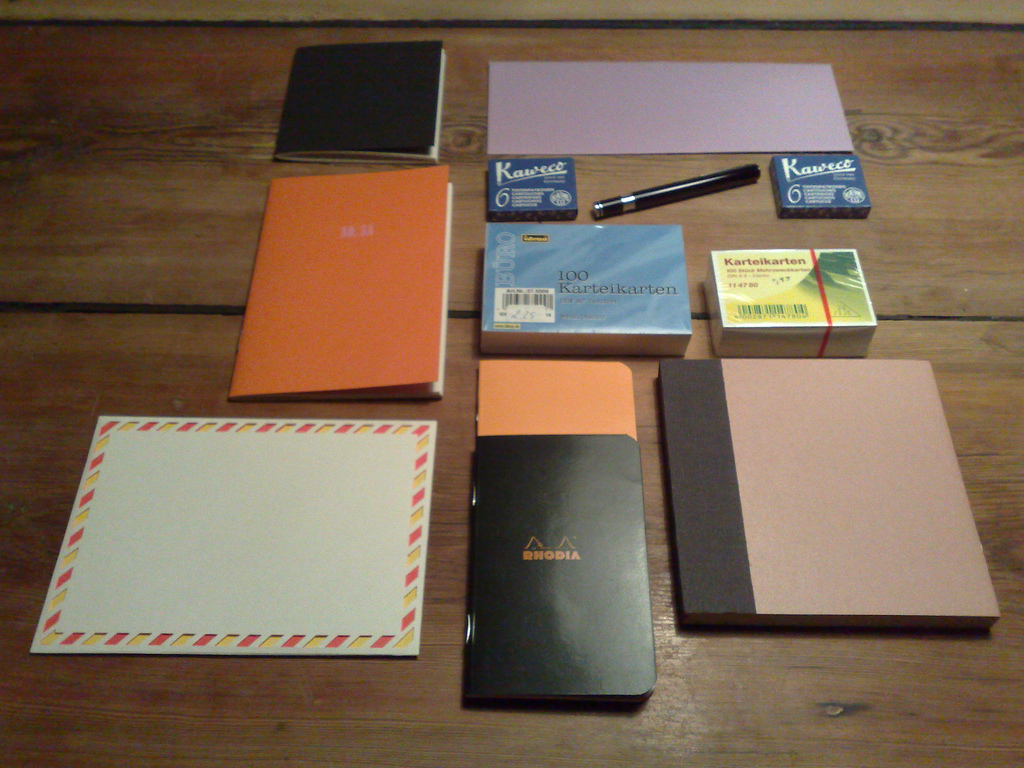
I’m putting this here simply so that future versions of myself – or other English-speaking travelers in Germany – can refer to it.
So you’ve got yourself a Vodafone CallYa pre-paid SIM card in Germany – easy and cheap to pick up at any Vodafone outlet in the country (when I went looking for one last March they were having a 5-for-1 sale, so I have five German mobile numbers working in rotation for a time). And you need to recharge your account now that you’ve extinguished its initial value. But how?
I tried many times, in vain, to recharge online at Vodafone.de – it seems like it’s actually not possible. In theory you can buy a CallNow scratch card from kiosks, but that’s not always convenient or lingually possible.
Fortunately there’s a solution: aufladen.de. From that site you can purchase online, in English, a 15 or 30 Euro “top up code” by credit card that gets delivered to you by email and can then be entered on the phone by calling Vodafone’s 22922 line.
I did this today, and it worked as expected, with the following caveats:
- I appeared to need a German address, at least when paying by credit card: I kept getting an error message about a missing postal code when I used my Canadian address. I ended up using the address of my temporary Berlin apartment and the transaction processed without further problems.
- It’s possible that when you dial 22922 you’ll get messaging only in German. To switch your Vodafone language to English. press 4 and then 2; all future calls will then be in English.
- The code took about 3 minutes to arrive by email; be patient.
I still haven’t quite figured out how to tell what CallYa plan I’m signed up for and what the rates are: all I know is that an afternoon of occasional data and SMS use comes out to about 1 EUR of charges, which seems reasonable to me.
I’m off to Berlin tomorrow for a week of respite, renewing ties with old friends, and, at the end of the week, the Cognitive Cities Conference, which is shaping up to be an interesting weekend of ideas about urbanism, design and technology.
For old time’s sake I’ve resurrected my old Plazes account – yes, Plazes is still there chugging away silently – and with that, and Twitter and Google Latitude you’ll have a hard time not knowing exactly where I am and what I’m doing at any given time.
I’m staying in an apartment cum furniture showroom from VitaminBerlin on Graefestraße 10 in Kreuzberg. Off to Berlin via Toronto and Munich on Air Canada tomorrow afternoon; back via Munich and Montreal on February 28th (travel details here).
Take care of the Island for me while I’m gone (and Happy Islander Day!).
Thanks to the kindness of Compass producer Tracy Lightfoot, here are some “behind the scenes” photos of Bruce Rainnie on set during the broadcast. Some interesting things (at least to me):
- Bruce is wearing jeans. I’d always assumed he was nattily dressed from head to toe. This is going to affect how I watch the news.
- The Darryl Sittler Wikipedia entry is open in Internet Explorer on the laptop.
- Bruce can see Boomer. I’d always wondered.
Thanks again to Tracy for sending these along via Twitter.

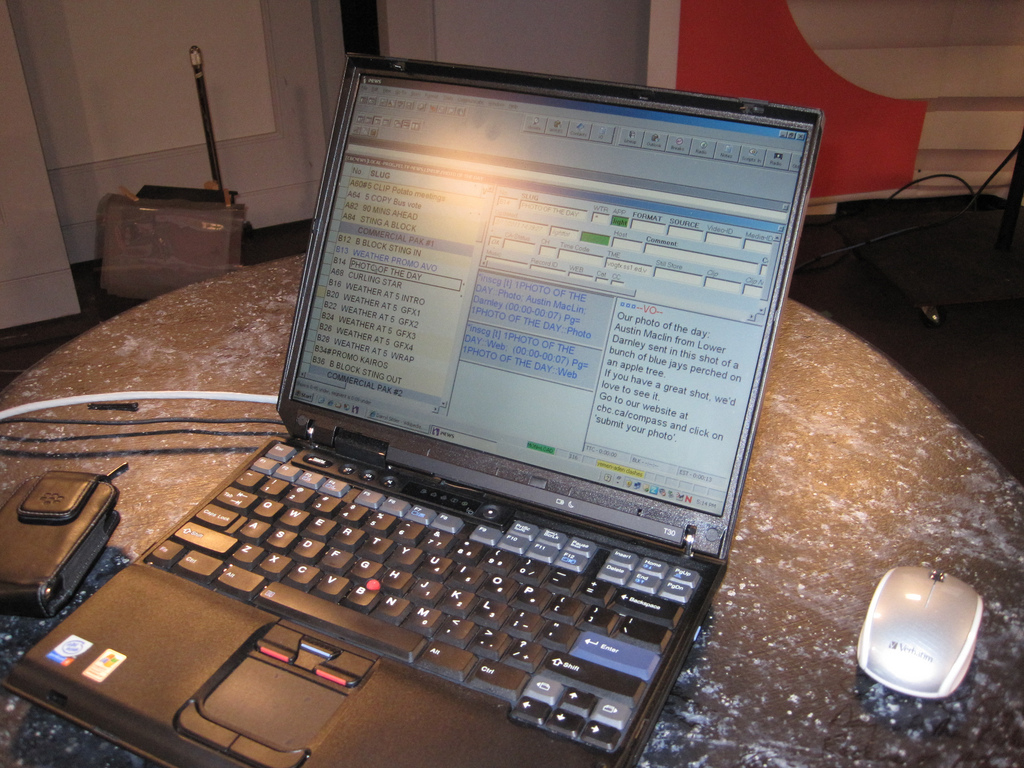

As an experiment, I’ve opened up a Reinvented Press Shop at Etsy.com to sell some of the items I’ve printed on the letterpress.
For those of us who follow Compass closely one of the great mysteries of life is the laptop that sits aside anchor Bruce Rainnie. What’s on the laptop? Does he use it to update Facebook during the breaks? Could we IM with Bruce when he has a spare moment? Or perhaps it’s just a dummy laptop that serves no function?
Alas these questions remain unanswered. But the laptop did have a larger-than-usual starring role in the closing seconds of last night’s broadcast:
Postscript
Some helpful tweets from Compass producer Tracy Lightfoot:
- LOL - you should ask me these things! it is on, he looks at it, and it shows the show lineup in case autocue goes down.
- one view has the title of the stories and the order, the other has the text. he can toggle back and forth.
You’ll also find a few “behind the scenes” photos of Compass on the Compass Facebook page.
The Prince Edward Island Department of Education released the Primary Mathematics Assessment results yesterday. These are the results of testing of students who were in Grade 3 in 2009-2010 and were tested on their mathematics skills in October 2010.
There were 1,295 students tested, and the results were as follows:
- met expectations: 68%
- approached expectations: 12%
- experienced difficulty: 20%
Here are three news headlines that resulted from the news release announcing the results, Results from Primary Math Assessments available online:
- Numbers add up for Grade 3 students and math testing: Currie
- Education minister pleased with math results
- Young Islanders meeting standards in mathematics
There was a similar story in Nova Scotia in 2008, reporting on that province’s grade 3 math assessment; in that case the headline on the CBC was Nova Scotia Grade 3 students struggle with math.
In that story the lede was “One-third of the children tested last year did not meet expectations in the province’s first Early Elementary Mathematical Literacy Assessment.” Which turns out to be almost exactly the same number of students “not meeting expectations” in Prince Edward Island’s assessment.
So in Prince Edward Island the minister is “pleased,” the “numbers add up” and students are “meeting standards” whereas, with the same result, in Nova Scotia student are “struggling” with math.
My problem, as a parent of a student in this group, is that I have no idea of who’s right on this: should I be pleased with the results, or concerned? Are our children being well-schooled in math or not? Do the results mean that 32% of 9 and 10 year olds in the province can’t add, or do they mean that 68% could go on to become mathematicians?
And this reveals the problem with standardized testing, especially when the results are wrapped in fuzzy words like “met expectations” that are useful for public relations but of little utility to parents. I remain unconvinced that there’s any utility at all in testing students like this, especially given the resources and attention that the testing takes away from actual education, and that the results can be spun to mean anything you want them to mean.
 I am
I am